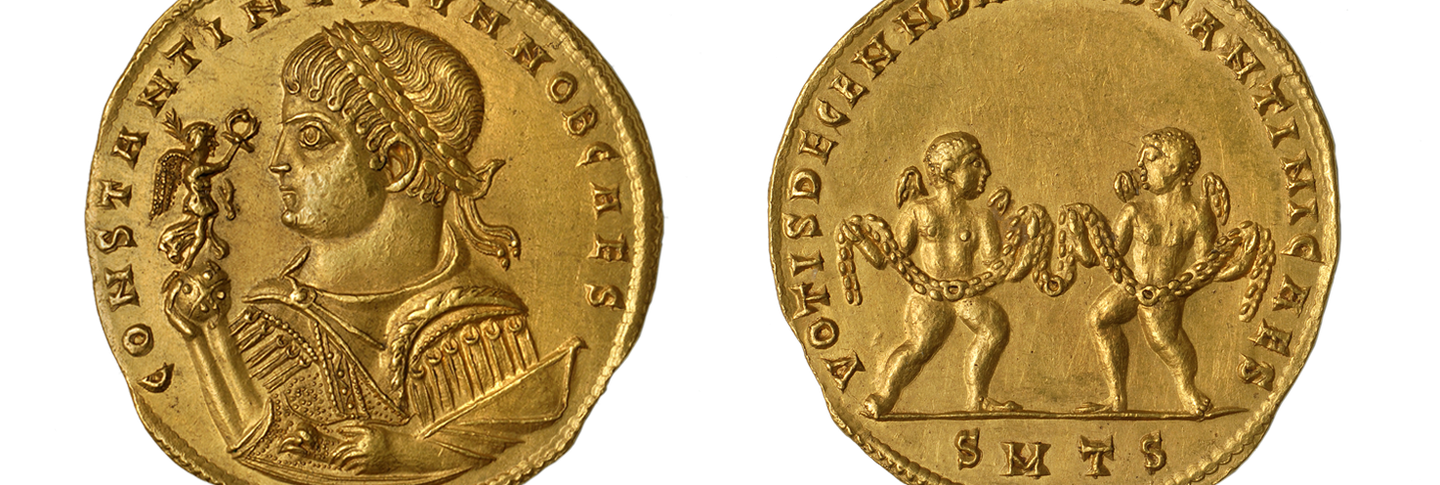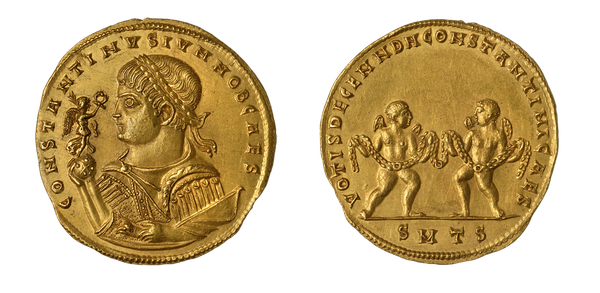Dumbarton Oaks’ world famous collection of Byzantine objects is equaled in importance and diversity by its collection of Byzantine coins and medallions. It comprises more than 12,000 specimens and covers the entire history of the long-lived empire. Although the collection includes some representative examples from the third century, comprehensive documentation begins with Constantine the Great (r. 306–337), who founded Constantinople in 324 CE, and continues through all the imperial rulers, many empresses, and even a number of usurpers up to the last legitimate ruler, Constantine XI (r. 1449–1453), who died defending the capital city against the Ottoman Turks.
There are examples of all the denominations struck at different times in the economic history of Byzantium, including gold, silver, bronze, electrum, and copper issues that, in five major catalogues, have been interpreted and made available to the scholarly and interested public.
The featured example below (BZC.1949.5) is a medallion of Constantine II (Caesar, 317–337; Augustus, 337–340) and was issued in Thessalonike in the year 326 or 327. Its diameter of 32 mm (1 ¼ inches) and weight of 13.5 grams speak to its outstanding value. It is a special coin, a multiple of the solidus—the standard gold coin weighing 4.5 grams minted for commercial transactions—struck as a commemorative medallion to mark an imperial anniversary. This three-solidi medallion celebrated the tenth year (decennalia) of Constantine II as Caesar.
The outstanding coin has a very well documented long record of ownership. It was purchased by Dumbarton Oaks from the J. Pierpont Morgan Library Collection in 1949; previously it was in the Consul E. F. Weber Collection (sold in 1909); and before that in the Vicomte Ponton d’Amécourt Collection (sold in Paris in 1887).
A considerable number of late Roman coins of the fourth century, together with a substantial number of medallions from the same period, form a significant part of the numismatic collection. The medallions were published in Dumbarton Oaks Papers 12 (1958) by Alfred R. Bellinger and the gold and silver coins of the late third and fourth centuries in Dumbarton Oaks Papers 18 (1964) by Alfred R. Bellinger et al.
The most recent article discussing imperial medallions distributed as largesse is soon to appear in J.-M. Spieser, E. Yota, ed., Donation et donateurs à Byzance, Réalités byzantines 14 (2012): 25-46, written by Dumbarton Oaks’ Numismatics Advisor Cécile Morrisson.
Museum plans for the near future include adding a ‘timeline of Byzantine emperors’ to our website that will present all the Byzantine rulers from Constantine the Great to Constantine XI, each illustrated by a coin from the collection, and presenting the entire collection online, modeled after the Byzantine Seals Online Catalogue.
Obverse (left): Bust of Constantine, a son of Constantine the Great, facing left with a laurel crown, wearing a paludamentum (military cape) and holding a globe surmounted by a Victory in his right hand and an eagle-topped scepter or sword in his left. Inscription: CONSTANTINVS IVN NOB CAES.
Reverse (right): Two genii facing each other and holding a garland of flowers. Inscription: VOTIS DECENN D N CONSTANTINI CAES. In the exergue (below the ground line): SMTS.

